投资练习题(含答案)
第五章项目投资课堂练习及答案
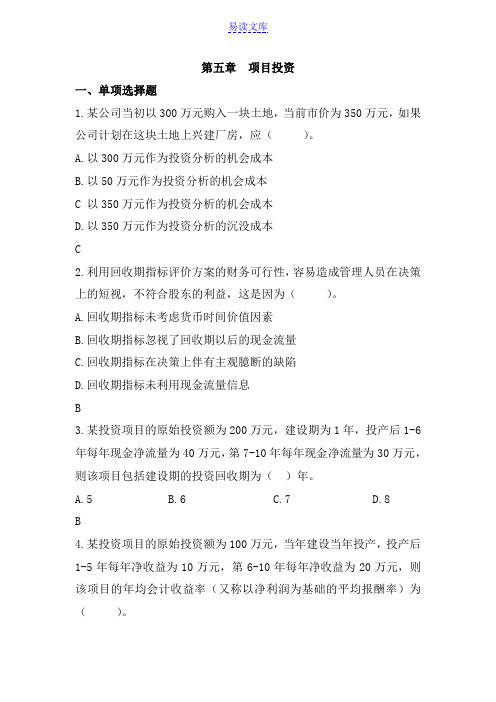
第五章项目投资一、单项选择题1.某公司当初以300万元购入一块土地,当前市价为350万元,如果公司计划在这块土地上兴建厂房,应()。
A.以300万元作为投资分析的机会成本B.以50万元作为投资分析的机会成本C 以350万元作为投资分析的机会成本D.以350万元作为投资分析的沉没成本C2.利用回收期指标评价方案的财务可行性,容易造成管理人员在决策上的短视,不符合股东的利益,这是因为()。
A.回收期指标未考虑货币时间价值因素B.回收期指标忽视了回收期以后的现金流量C.回收期指标在决策上伴有主观臆断的缺陷D.回收期指标未利用现金流量信息B3.某投资项目的原始投资额为200万元,建设期为1年,投产后1-6年每年现金净流量为40万元,第7-10年每年现金净流量为30万元,则该项目包括建设期的投资回收期为()年。
A.5B.6C.7D.8B4.某投资项目的原始投资额为100万元,当年建设当年投产,投产后1-5年每年净收益为10万元,第6-10年每年净收益为20万元,则该项目的年均会计收益率(又称以净利润为基础的平均报酬率)为()。
A.5%B.10%C.15%D.30%C8.在下列评价指标中,未考虑货币时间价值的是()。
A.净现值B.内部收益率C.获利指数D.回收期D二、多项选择题1.下列各项中,属于现金流出项目的有()。
A.建设投资B.经营成本C.长期待摊费用摊销D.固定资产折旧E.所得税支出AE2.某公司拟于2003年初新建一生产车间用于某种新产品的开发,则与该投资项目有关的现金流量是()。
A.需购置新的生产流水线,价值为300万元,同时垫付25万元的流动资金B.2002年公司支付5万元的咨询费,请专家论证C.公司全部资产目前已经提折旧100万元D.利用现有的库存材料,目前市价为20万元E.投产后每年创造销售收入100万元AE◆现金流入量--营业收入、回收固定资产残值、回收流动资金、其他现金流入◆现金流出量--固定资产投资支出、垫支营运资本、付现成本、税金、其他现金流出净现金流量=现金流入量-现金流出量3.下列项目中,属于非贴现评价指标的有()。
投资学题库及答案

投资学题库及答案《投资学》(第四版)练习题第1章投资概述习题⼀、单项选择题1、下列⾏为不属于投资的是()。
CA. 购买汽车作为出租车使⽤B. 农民购买化肥C. 购买商品房⾃⼰居住D. 政府出资修筑⾼速公路2、投资的收益和风险往往()。
AA. 同⽅向变化B. 反⽅向变化C. 先同⽅向变化,后反⽅向变化D. 先反⽅向变化,后同⽅向变化⼆、判断题1、资本可以有各种表现形态,但必须有价值。
()√2、证券投资是以实物投资为基础的,是实物投资活动的延伸。
()√3、从银⾏贷款从事房地产投机的⼈不是投资主体。
()×三、多项选择题1、以下是投资主体必备条件的有()ABDA.拥有⼀定量的货币资⾦ B.对其拥有的货币资⾦具有⽀配权C.必须能控制其所投资企业的经营决策 D.能够承担投资的风险2、下列属于真实资本有()ABCA.机器设备 B.房地产 C.黄⾦ D.股票3、下列属于直接投资的有()ABA.企业设⽴新⼯⼚ B.某公司收购另⼀家公司60%的股权C.居民个⼈购买1000股某公司股票 D.发放长期贷款⽽不参与被贷款企业的经营活动四、简答题1、直接投资与间接投资第2章市场经济与投资决定习题⼀、单项选择题1、市场经济制度与计划经济制度的最⼤区别在于()。
BA. 两种经济制度所属社会制度不⼀样D. 两种经济制度的⽣产资料所有制不⼀样2、市场经济配置资源的主要⼿段是()。
?DA. 分配机制B. 再分配机制C. ⽣产机制D. 价格机制⼆、判断题1、在市场经济体制下,⾃利性是经济活动主体从事经济活动的内在动⼒。
()√2、产权不明晰或产权缺乏严格的法律保护是造成市场失灵的重要原因之⼀。
()×3、按现代产权理论,完整意义上的产权主要是指对⼀种物品或资源的⽀配使⽤权、⾃由转让权以及剩余产品的收益权。
()×四、简答题1、市场失灵、缺陷第3章证券投资概述习题⼀、单项选择题1、在下列证券中,投资风险最低的是()AA、国库券B、⾦融债券C、国际机构债券D、公司债券2、中国某公司在美国发⾏的以欧元为⾯值货币的债券称之为()BA.外国债券 B.欧洲债券 C.武⼠债券 D.扬基债券3、中央银⾏在证券市场市场买卖证券的⽬的是()DA、赚取利润B、控制股份C、分散风险D、宏观调控4、资本证券主要包括()。
投资学题库及答案

《投资学》(第四版)练习题第1章投资概述习题一、单项选择题1、下列行为不属于投资的是()。
CA. 购买汽车作为出租车使用B. 农民购买化肥C. 购买商品房自己居住D. 政府出资修筑高速公路2、投资的收益和风险往往()。
AA. 同方向变化B. 反方向变化C. 先同方向变化,后反方向变化D. 先反方向变化,后同方向变化二、判断题1、资本可以有各种表现形态,但必须有价值。
()√2、证券投资是以实物投资为基础的,是实物投资活动的延伸。
()√3、从银行贷款从事房地产投机的人不是投资主体。
()×三、多项选择题1、以下是投资主体必备条件的有()ABDA.拥有一定量的货币资金 B.对其拥有的货币资金具有支配权C.必须能控制其所投资企业的经营决策 D.能够承担投资的风险2、下列属于真实资本有()ABCA.机器设备 B.房地产 C.黄金 D.股票3、下列属于直接投资的有()ABA.企业设立新工厂 B.某公司收购另一家公司60%的股权C.居民个人购买1000股某公司股票 D.发放长期贷款而不参与被贷款企业的经营活动四、简答题1、直接投资与间接投资第2章市场经济与投资决定习题一、单项选择题1、市场经济制度与计划经济制度的最大区别在于()。
BA. 两种经济制度所属社会制度不一样B. 两种经济制度的基础性资源配置方式不一样C. 两种经济制度的生产方式不一样D. 两种经济制度的生产资料所有制不一样2、市场经济配置资源的主要手段是()。
DA. 分配机制B. 再分配机制C. 生产机制D. 价格机制二、判断题1、在市场经济体制下,自利性是经济活动主体从事经济活动的内在动力。
()√2、产权不明晰或产权缺乏严格的法律保护是造成市场失灵的重要原因之一。
()×3、按现代产权理论,完整意义上的产权主要是指对一种物品或资源的支配使用权、自由转让权以及剩余产品的收益权。
()×四、简答题1、市场失灵、缺陷第3章证券投资概述习题一、单项选择题1、在下列证券中,投资风险最低的是()AA、国库券B、金融债券C、国际机构债券D、公司债券2、中国某公司在美国发行的以欧元为面值货币的债券称之为()BA.外国债券 B.欧洲债券 C.武士债券 D.扬基债券3、中央银行在证券市场市场买卖证券的目的是()DA、赚取利润B、控制股份C、分散风险D、宏观调控4、资本证券主要包括()。
投资决策习题及参考答案

第3章 资本预算习题一、计算分析题:1.某公司拟投资一条新的生产线用于生产产品。
生产线的购置成本、运输及安装成本等共计1 000万元。
生产线开始投产时需垫支100万元的流动资金。
该生产线预计使用寿命为5年,直线法折旧,5年后净残值为50万元。
5年中年产量预计分别为50 000台、80 000台、120 000台、100 000台和60 000台,第1年产品单位售价为400元,预计其单位售价每年增长2%。
同时用于制造产品的单位变动成本第1年为200元,预计以后每年增长10%。
公司所得税率为25%。
试估算该项目各年的现金净流量。
试估算该项目各年的现金净流量。
2.某企业经过市场调研,计划投资于新产品A ,调研支出40 000万元。
生产A 产品需购买机器设备,初始投资共计210 000元,并且占用企业本可以对外出售的土地及房屋,售价240 240 000000元(此价格水平至少维持5年)。
机器设备的使用寿命和折旧年限同为5年,预计净残值为10 000元,直线法折旧。
A 产品投产时垫支营运资金30 000元,第5年投资结束时,营运资金全部从项目中退出。
预计投产后第1年的营业收入为200 000元,以后每年增加10 000元,营业税率8%,营业成本(含折旧)为100 000元,每年的财务费用和管理费用分别为10 10 000000元,公司所得税率为25%,投资要求的必要收益率为10%,假设所在现金流量都在年末发生。
金流量都在年末发生。
要求:(1)估计该项目各年的现金净流量;)估计该项目各年的现金净流量; (2)计算该项目的投资回收期;)计算该项目的投资回收期;(3)计算该项目的净现值、盈利指数和内部收益率;)计算该项目的净现值、盈利指数和内部收益率; (4)根据上述计算结果判断该项目是否应该投资。
)根据上述计算结果判断该项目是否应该投资。
3.某公司拟采用新设备取代已使用3年的旧设备,旧设备原价14 950元,当前估计尚可使用5年,每年操作成本2 150元,预计最终残值为1 750元,目前变现价值为8 500元,购置新设备需花费13 750元,预计可使用6年,每年操作成本850元,残值收入为2 500元,预计所得税税率为30%30%,税法规定该类设备应采用直线法折旧,折旧年限为,税法规定该类设备应采用直线法折旧,折旧年限为6年,残值为原值的10%.要求:进行是否应该更新设备的分析决策,并列出计算过程。
投资学练习题及答案doc
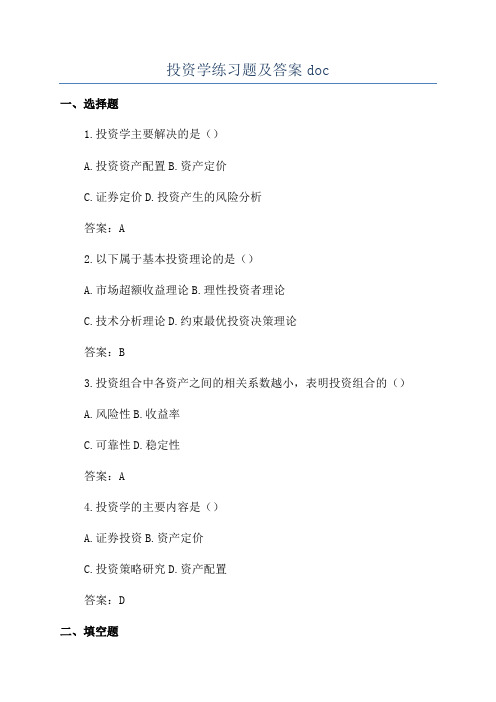
投资学练习题及答案doc
一、选择题
1.投资学主要解决的是()
A.投资资产配置
B.资产定价
C.证券定价
D.投资产生的风险分析
答案:A
2.以下属于基本投资理论的是()
A.市场超额收益理论
B.理性投资者理论
C.技术分析理论
D.约束最优投资决策理论
答案:B
3.投资组合中各资产之间的相关系数越小,表明投资组合的()
A.风险性
B.收益率
C.可靠性
D.稳定性
答案:A
4.投资学的主要内容是()
A.证券投资
B.资产定价
C.投资策略研究
D.资产配置
答案:D
二、填空题
5.投资学的基本原理是,投资者应尽可能通过正确的投资组合减少投资风险与保证投资收益,以实现____________的最大化。
答案:投资收益
6.用投资学的思想来构建投资组合,则是基于____________的理论支撑。
答案:多元化
7.投资策略的设计应充分考虑市场的____________,科学分析投资风险以达到投资的最优选择。
长期股权投资习题(含答案)

第五章长期股权投资习题一、单项选择题1.企业采用成本法核算长期股权投资时,收到被投资单位分派的现金股利时,若为投资后产生的净利润分配的,应当()。
A.减少长期股权投资 B.冲减应收股利C.增加实收资本 D.计入投资收益2.采用权益法核算长期股权投资时,被投资单位发生亏损投资企业按应分担的份额应当()。
A.减少长期股权投资账面价值 B.冲减应收股息C.冲减资本公积 D.计入营业外支出3.关于长期股权投资的成本法和权益法核算,下列说法正确的是()。
A.取得长期股权投资时投资成本的入账价值相同B.被投资企业发生净损益时的处理方法相同C.计提减值准备的条件相同D.确认的投资收益金额相同4.对同一控制下的企业合并,合并方以发行权益性证券作为合并对价的,下列说法中正确的是()。
A.应当在合并日按照取得被合并方所有者权益公允价值的份额作为长期股权投资的初始投资成本,按照发行股份的面值总额作为股本B.应当在合并日按照取得被合并方可辨认净资产公允价值的份额作为长期股权投资的初始投资成本,按照发行股份的面值总额作为股本C.应当在合并日按照取得被合并方所有者权益账面价值的份额作为长期股权投资的初始投资成本,按照发行股份的面值总额作为股本,长期股权投资初始投资成本与所发行股份面值总额之间的差额,应当计入资本公积D.应当在合并日按照取得被合并方所有者权益账面价值的份额作为长期股权投资的初始投资成本,按照发行股份的面值总额作为股本,长期股权投资初始投资成本与所发行股份面值总额之间的差额,应当计入当期损益5.甲公司出资1 000万元,取得了乙公司80%的控股权,假如购买股权时乙公司的账面净资产价值为1 500万元,甲、乙公司合并前后同受一方控制。
则甲公司确认的长期股权投资成本为()万元。
A.1000 B.1500 C.800 D.12006.甲公司出资1 000万元,取得了乙公司80%的控股权,假如购买股权时乙公司的账面净资产价值为1 500万元,甲、乙公司合并前后不受同一方控制。
9 证券投资练习(含答案)
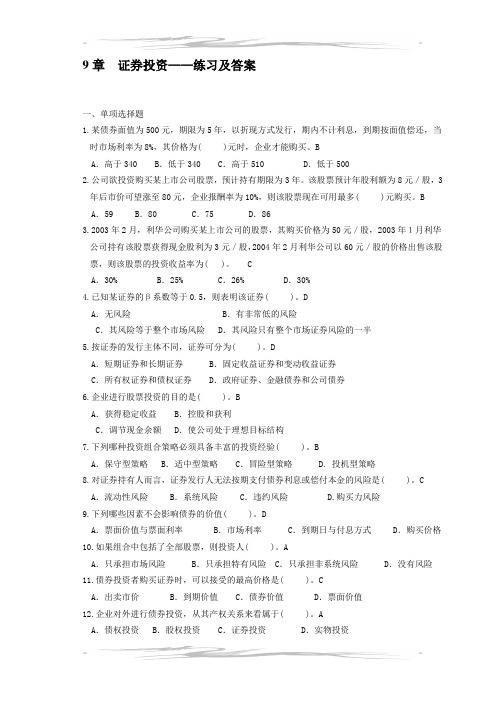
9章证券投资——练习及答案一、单项选择题1.某债券面值为500元,期限为5年,以折现方式发行,期内不计利息,到期按面值偿还,当时市场利率为8%,其价格为( )元时,企业才能购买。
BA.高于340 B.低于340 C.高于510 D.低于5002.公司欲投资购买某上市公司股票,预计持有期限为3年。
该股票预计年股利额为8元/股,3年后市价可望涨至80元,企业报酬率为10%,则该股票现在可用最多( )元购买。
BA.59 B.80 C.75 D.863.2003年2月,利华公司购买某上市公司的股票,其购买价格为50元/股,2003年1月利华公司持有该股票获得现金股利为3元/股,2004年2月利华公司以60元/股的价格出售该股票,则该股票的投资收益率为( )。
CA.30% B.25% C.26% D.30%4.已知某证券的β系数等于0.5,则表明该证券( )。
DA.无风险 B.有非常低的风险C.其风险等于整个市场风险 D.其风险只有整个市场证券风险的一半5.按证券的发行主体不同,证券可分为( )。
DA.短期证券和长期证券 B.固定收益证券和变动收益证券C.所有权证券和债权证券 D.政府证券、金融债券和公司债券6.企业进行股票投资的目的是( )。
BA.获得稳定收益 B.控股和获利C.调节现金余额 D.使公司处于理想目标结构7.下列哪种投资组合策略必须具备丰富的投资经验( )。
BA.保守型策略 B.适中型策略 C.冒险型策略 D. 投机型策略8.对证券持有人而言,证券发行人无法按期支付债券利息或偿付本金的风险是( )。
CA.流动性风险 B.系统风险 C.违约风险 D.购买力风险9.下列哪些因素不会影响债券的价值( )。
DA.票面价值与票面利率 B.市场利率 C.到期日与付息方式 D.购买价格10.如果组合中包括了全部股票,则投资人( )。
AA.只承担市场风险 B.只承担特有风险 C.只承担非系统风险 D.没有风险11.债券投资者购买证券时,可以接受的最高价格是( )。
《投资学》习题及答案
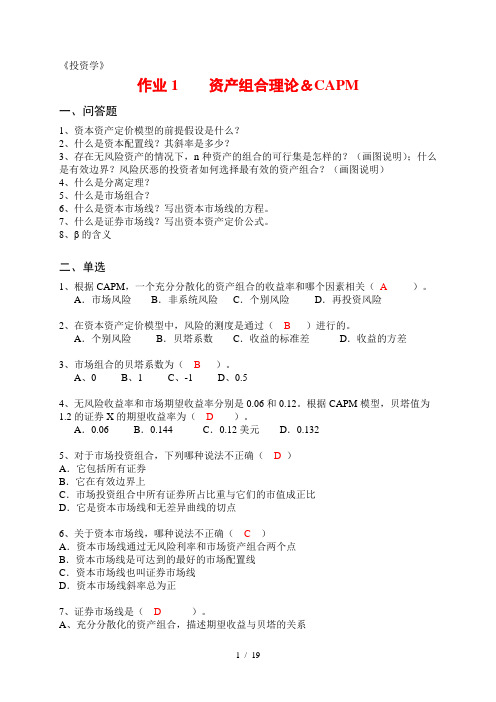
《投资学》作业1资产组合理论&CAPM一、问答题1、资本资产定价模型的前提假设是什么?2、什么是资本配置线?其斜率是多少?3、存在无风险资产的情况下,n种资产的组合的可行集是怎样的?(画图说明);什么是有效边界?风险厌恶的投资者如何选择最有效的资产组合?(画图说明)4、什么是分离定理?5、什么是市场组合?6、什么是资本市场线?写出资本市场线的方程。
7、什么是证券市场线?写出资本资产定价公式。
8、β的含义二、单选1、根据CAPM,一个充分分散化的资产组合的收益率和哪个因素相关(A )。
A.市场风险B.非系统风险C.个别风险D.再投资风险2、在资本资产定价模型中,风险的测度是通过(B)进行的。
A.个别风险B.贝塔系数C.收益的标准差D.收益的方差3、市场组合的贝塔系数为(B)。
A、0B、1C、-1D、0.54、无风险收益率和市场期望收益率分别是0.06和0.12。
根据CAPM模型,贝塔值为1.2的证券X的期望收益率为(D)。
A.0.06 B.0.144 C.0.12美元D.0.1325、对于市场投资组合,下列哪种说法不正确(D)A.它包括所有证券B.它在有效边界上C.市场投资组合中所有证券所占比重与它们的市值成正比D.它是资本市场线和无差异曲线的切点6、关于资本市场线,哪种说法不正确(C)A.资本市场线通过无风险利率和市场资产组合两个点B.资本市场线是可达到的最好的市场配置线C.资本市场线也叫证券市场线D.资本市场线斜率总为正7、证券市场线是(D)。
A、充分分散化的资产组合,描述期望收益与贝塔的关系B、也叫资本市场线C、与所有风险资产有效边界相切的线D、描述了单个证券(或任意组合)的期望收益与贝塔关系的线8、根据CAPM模型,进取型证券的贝塔系数(D)A、小于0B、等于0C、等于1D、大于19、美国“9·11”事件发生后引起的全球股市下跌的风险属于(A)A、系统性风险B、非系统性风险C、信用风险D、流动性风险10、下列说法正确的是(C)A、分散化投资使系统风险减少B、分散化投资使因素风险减少C、分散化投资使非系统风险减少D、.分散化投资既降低风险又提高收益11、现代投资组合理论的创始者是(A)A.哈里.马科威茨B.威廉.夏普C.斯蒂芬.罗斯D.尤金.珐玛12、反映投资者收益与风险偏好有曲线是(D)A.证券市场线方程B.证券特征线方程C.资本市场线方程D.无差异曲线13、不知足且厌恶风险的投资者的偏好无差异曲线具有的特征是(B)A.无差异曲线向左上方倾斜B.收益增加的速度快于风险增加的速度C.无差异曲线之间可能相交D.无差异曲线位置与该曲线上的组合给投资者带来的满意程度无关14、反映证券组合期望收益水平和单个因素风险水平之间均衡关系的模型是(A)A.单因素模型B.特征线模型C.资本市场线模型D.套利定价模型三、多项选择题1、关于资本市场线,下列说法正确的是(ABD)。
投资管理练习试卷8(题后含答案及解析)

投资管理练习试卷8(题后含答案及解析)题型有:1. 单项选择题 2. 多项选择题 3. 判断题单项选择题每题只有一个正确答案,请从每题的备选答案中选出一个你认为最正确的答案,在答题卡相应位置上用2B铅笔填涂相应的答案代码。
答案写在试题卷上无效。
1.某公司新建厂房需使用公司拥有的一块土地,不必动用资金购买,但当初公司以60万元购入这块土地。
假设目前这块土地出售的市价为100万元,如欲在这块土地上兴建厂房,应( )。
A.以60万元作为投资分析的机会成本考虑B.以100万元作为投资分析的机会成本考虑C.以40万元作为投资分析的机会成本考虑D.以140万元作为投资分析的沉没成本考虑正确答案:B解析:只有土地的现行市价才是投资的代价,即其机会成本。
知识模块:投资管理2.某投资项目原始投资为6000万元,当年完工投产,寿命期3年,每年可获得现金净流量2300万元,则该项目内含报酬率为( )。
A.0.0733B.0.0768C.0.0832D.0.0668正确答案:A 涉及知识点:投资管理3.某企业购入一台生产设备,价款为5万元,年折旧率为10%。
预计投产后每年可获净利润0.75万元,则投资回收期为( )。
A.3年B.5年C.4年D.6年正确答案:C解析:回收期=原始投资额÷每年现金净流入量=原始投资额÷(净利润+折旧)=50000÷(7500+50000B10%)=4(年) 知识模块:投资管理4.一个投资方案年销售收入500万元,年营业成本380万元,其中折旧150万元,所得税为33%,则该方案年营业现金流量为( )万元。
A.80.4B.230.4C.120D.234.5正确答案:B 涉及知识点:投资管理5.下列说法中不正确的是( )。
A.按收付实现制计算的现金流量比按权责发生制计算的净收益更加可靠B.利用净现值不能揭示某投资方案可能达到的实际报酬率C.分别利用净现值,内含报酬率,投资回收期,现值指数法进行项目评价时,结果可能不一致D.投资回收期和会计收益率法都没有考虑回收期满后的现金流量正确答案:D解析:回收期法的缺点是没有考虑回收期以后的收益;但会计收益率法则考虑了项目计算期内的全部净收益,即现金流量。
投资学习题习题及答案

第一章投资环境1.假设你发现一只装有100亿美元的宝箱。
a.这是实物资产还是金融资产?b.社会财富会因此而增加吗?c.你会更富有吗?d.你能解释你回答b、c时的矛盾吗?有没有人因为这个发现而受损呢?a. 现金是金融资产,因为它是政府的债务。
b. 不对。
现金并不能直接增加经济的生产能力。
c. 是。
你可以比以前买入更多的产品和服务。
d. 如果经济已经是按其最大能力运行了,现在你要用这1 0 0亿美元使购买力有一额外增加,则你所增加的购买商品的能力必须以其他人购买力的下降为代价,因此,经济中其他人会因为你的发现而受损。
nni Products 是一家新兴的计算机软件开发公司,它现有计算机设备价值30000美元,以及由Lanni的所有者提供的20000美元现金。
在下面地交易中,指明交易涉及的实物资产或(和)金融资产。
在交易过程中有金融资产的产生或损失吗?nni公司向银行贷款。
它共获得50000美元的现金,并且签发了一张票据保证3年内还款。
nni公司使用这笔现金和它自有的20000美元为其一新的财务计划软件开发提供融资。
nni公司将此软件产品卖给微软公司(Microsoft),微软以它的品牌供应给公众,Lanni公司获得微软的股票1500股作为报酬。
nni公司以每股80元的价格卖出微软的股票,并用所获部分资金还贷款。
a. 银行贷款是L a n n i公司的金融债务;相反的,L a n n i的借据是银行的金融资产。
L a n n i获得的现金是金融资产,新产生的金融资产是Lanni 公司签发的票据(即公司对银行的借据)。
b. L a n n i公司将其金融资产(现金)转拨给其软件开发商,作为回报,它将获得一项真实资产,即软件成品。
没有任何金融资产产生或消失;现金只不过是简单地从一方转移给了另一方。
c. L a n n i公司将其真实资产(软件)提供给微软公司以获得一项金融资产—微软的股票。
由于微软公司是通过发行新股来向L a n n i支付的,这就意味着新的金融资产的产生。
投资学练习题A 答案版

练习题A一、填空题1.交易所的组织模式可以分为(会员制交易所)和(公司制交易所)两种类型。
2.投资主体按投资目标分为(成长型收入型和平衡型基金)。
3.证券投资基金的投资特点是(集合投资分散风险专业理财)。
4.股票可以分为(普通股和优先股)。
5.行业分析理论方法分为(定性分析方法和定量分析方法)。
6.(远期利率)是指投资者同意在未来的某一特定日期购买的零息票债券的到期收益率,记为fn。
7.技术分析是建立在(市场行为包括一切信息、价格沿趋势波动并保持趋势、历史会重复)三个假设的基础上。
8.现货-远期平价定理是进行(远期合约定价)的基础。
9.(期货合约)是一种在将来某一确定日期按照确定的价格交割特定数量资产的协议。
10.当股价突然暴涨,距离移动平均线很远,乖离过大时,就是(卖出)的时机。
11.ETF的申购是指投资者用指定的一篮子指数成份股实物向基金管理公司换取固定数量的(ETF份额)12.变异系数的值越大,表明获得该单位收益所承担的风险(越大),即该资产越没有投资价值。
13.资产组合理论所要解决的核心问题是,以不同资产构建一个投资组合,提供确定组合中不同资产的权重,达到使组合(风险)最小的目的。
14.β系数所衡量的是市场(系统性风险)的大小。
15.(因子模型)不是均衡模型,而资本资产定价模型为均衡模型。
16.夏普指数和特雷纳指数衡量的是(单位风险)下的超额收益,而詹森指数给出的为(绝对差异率)。
17.(惯性投资策略),也叫动量交易策略,即购入过去表现良好的股票,卖出前段时期表现不好的股票。
18.对给定的收益率变动幅度,债券利息率与债券价格的波动幅度呈(反比关系)。
19.市政债券是由州或地方政府发行的债券,一般具有(免税性)。
20.将远期利率与将来的期望即期利率之间的差称为(流动性溢价)。
21.市场上的有价证券具有多重职能,既可作为筹资工具,又可作为____,还可用于____.答案:投资工具,保值和投机。
投资学习题及答案6.16
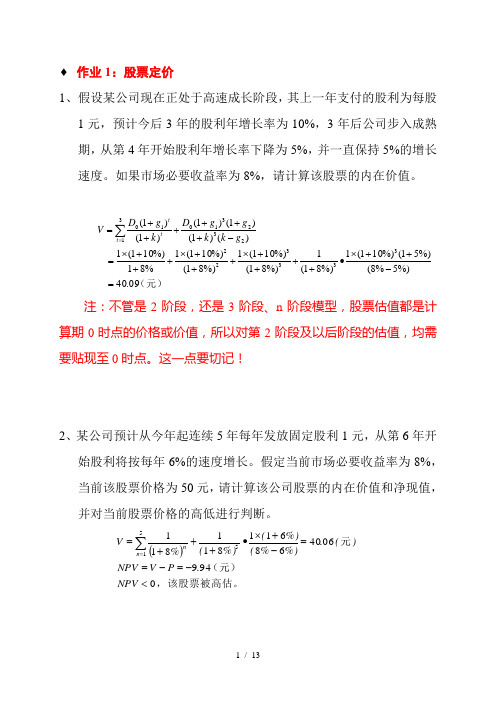
♦ 作业1:股票定价1、假设某公司现在正处于高速成长阶段,其上一年支付的股利为每股1元,预计今后3年的股利年增长率为10%,3年后公司步入成熟期,从第4年开始股利年增长率下降为5%,并一直保持5%的增长速度。
如果市场必要收益率为8%,请计算该股票的内在价值。
(元) 09.40%)5%8(%)51(%)101(1%)81(1%)81(%)101(1%)81(%)101(1%81%)101(1)()1()1()1()1()1(3333222323103110=-++⨯•++++⨯+++⨯+++⨯=-++++++=∑=g k k g g D k g D V t tt 注:不管是2阶段,还是3阶段、n 阶段模型,股票估值都是计算期0时点的价格或价值,所以对第2阶段及以后阶段的估值,均需要贴现至0时点。
这一点要切记!2、某公司预计从今年起连续5年每年发放固定股利1元,从第6年开始股利将按每年6%的速度增长。
假定当前市场必要收益率为8%,当前该股票价格为50元,请计算该公司股票的内在价值和净现值,并对当前股票价格的高低进行判断。
(),该股票被高估。
(元)元0949064068611811811551<-=-==-+⨯•+++=∑=NPV .P V NPV )(.%)%(%)(%)(%V n n3、某股份公司去年支付每股股利1元,预计在未来该公司股票股利按每年6%的速率增长,假定必要收益率为8%,请计算该公司股票的内在价值。
当前该股票价格为30元,请分别用净现值法和内部收益率法判断该股票的投资价值。
(1)净现值法:)(%%%)(V 元5368611=-+⨯=。
低估,建议购买该股票,所以当前股票价格被023>=-=P V NPV(2)内部收益率法:30=%6%)61(1-+⨯r , r =9.5%>8%(必要收益率)当前股票价格被低估,建议购买该股票。
4、某上市公司上年每股股利为0.3元,预计以后股利每年以3%的速度递增。
投资学练习题及答案

作业1 资产组合理论&CAPM一、基本概念1、资本资产定价模型的前提假设是什么?2、什么是资本配置线?其斜率是多少?3、存在无风险资产的情况下,n种资产的组合的可行集是怎样的?(画图说明);什么是有效边界?风险厌恶的投资者如何选择最有效的资产组合?(画图说明)4、什么是分离定理?5、什么是市场组合?6、什么是资本市场线?写出资本市场线的方程。
7、什么是证券市场线?写出资本资产定价公式。
8、β的含义二、单选1、根据CAPM,一个充分分散化的资产组合的收益率和哪个因素相关( A )。
A.市场风险 B.非系统风险 C.个别风险 D.再投资风险2、在资本资产定价模型中,风险的测度是通过( B )进行的。
A.个别风险 B.贝塔系数 C.收益的标准差 D.收益的方差3、市场组合的贝塔系数为( B )。
A、0B、1C、-1D、0.54、无风险收益率和市场期望收益率分别是0.06和0.12。
根据CAPM模型,贝塔值为1.2的证券X的期望收益率为( D )。
A.0.06 B.0.144 C.0.12美元 D.0.1325、对于市场投资组合,下列哪种说法不正确( D )A.它包括所有证券B.它在有效边界上C.市场投资组合中所有证券所占比重与它们的市值成正比D.它是资本市场线和无差异曲线的切点6、关于资本市场线,哪种说法不正确( C )A.资本市场线通过无风险利率和市场资产组合两个点B.资本市场线是可达到的最好的市场配置线C.资本市场线也叫证券市场线D.资本市场线斜率总为正7、证券市场线是( D )。
A、充分分散化的资产组合,描述期望收益与贝塔的关系B、也叫资本市场线C、与所有风险资产有效边界相切的线D、描述了单个证券(或任意组合)的期望收益与贝塔关系的线8、根据CAPM模型,进取型证券的贝塔系数( D )A、小于0B、等于0C、等于1D、大于19、美国“9·11”事件发生后引起的全球股市下跌的风险属于( A )A、系统性风险B、非系统性风险C、信用风险D、流动性风险10、下列说法正确的是( C )A、分散化投资使系统风险减少B、分散化投资使因素风险减少C、分散化投资使非系统风险减少D、.分散化投资既降低风险又提高收益11、现代投资组合理论的创始者是( A )A.哈里.马科威茨B.威廉.夏普C.斯蒂芬.罗斯D.尤金.珐玛12、反映投资者收益与风险偏好有曲线是( D )A.证券市场线方程B.证券特征线方程C.资本市场线方程D.无差异曲线13、不知足且厌恶风险的投资者的偏好无差异曲线具有的特征是( B)A.无差异曲线向左上方倾斜B.收益增加的速度快于风险增加的速度C.无差异曲线之间可能相交D.无差异曲线位置与该曲线上的组合给投资者带来的满意程度无关14、反映证券组合期望收益水平和单个因素风险水平之间均衡关系的模型是( A )A.单因素模型B.特征线模型C.资本市场线模型D.套利定价模型三、多项选择题1、关于资本市场线,下列说法正确的是( ABD )。
财务管理专业习题--投资(习题+答案)

投资管理一、单项选择题2. 项目投资决策中,完整的项目计算期是指( )。
A.建设期B.生产经营期C.建设期+达产期D.建设期+运营期4. 净现值属于()。
A.静态评价指标B.反指标C.次要指标D.主要指标5.按照投资行为的介入程度,可将投资分为()。
A.直接投资和间接投资B.生产性投资和非生产性投资C.对内投资和对外投资D.固定资产投资和信托投资6.甲企业拟建的生产线项目,预计投产第一年初的流动资产需用额为50万元,流动负债需用额为25万元,预计投产第二年初流动资产需用额为65万元,流动负债需用额为30万元,则投产第二年新增的流动资金投资额应为()万元。
A.25B.35C.10D.157. 某投资项目年营业收入为180万元,年付现成本为60万元,年折旧额为40万元,所得税税率为25%,则该项目年经营净现金流量为()万元。
A.81.8B.100C.82.4D.76.48. 下列投资项目评价指标中,不受建设期长短、投资回收时间先后及现金流量大小影响的评价指标是()。
A.静态投资回收期B.总投资收益率C.净现值率D.内部收益率9.某投资项目原始投资为12000元,当年完工投产,有效期3年,每年可获得现金净流量4600元,则该项目内部收益率为( )。
A.7.33%B.7.68%C.8.32%D.6.68%10.如果某一投资方案的净现值为正数,则必然存在的结论是()。
A.投资回收期在一年以内B.净现值率大于0C.总投资收益率高于100%D.年均现金净流量大于原始投资额12.已知某投资项目的原始投资额为350万元,建设期为2年,投产后第1至5年每年NCF为60万元,第6至10年每年NCF为55万元。
则该项目包括建设期的静态投资回收期为( )年。
A.7.909B.8.909C.5.833D.6.83315.下列指标的计算中,没有直接利用净现金流量的是( )。
A.净现值 B. 净现值率C.内部收益率 D.总投资收益率16.若某投资项目的净现值为15万元,包括建设期的静态投资回收期为5年,项目计算期为7年,运营期为6年,则该方案()。
证券投资习题及答案
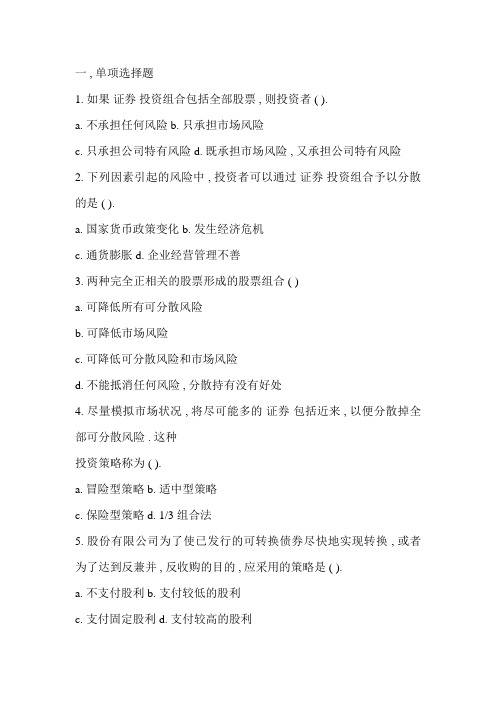
一 , 单项选择题1. 如果证券投资组合包括全部股票 , 则投资者 ( ).a. 不承担任何风险b. 只承担市场风险c. 只承担公司特有风险d. 既承担市场风险 , 又承担公司特有风险2. 下列因素引起的风险中 , 投资者可以通过证券投资组合予以分散的是 ( ).a. 国家货币政策变化b. 发生经济危机c. 通货膨胀d. 企业经营管理不善3. 两种完全正相关的股票形成的股票组合 ( )a. 可降低所有可分散风险b. 可降低市场风险c. 可降低可分散风险和市场风险d. 不能抵消任何风险 , 分散持有没有好处4. 尽量模拟市场状况 , 将尽可能多的证券包括近来 , 以便分散掉全部可分散风险 . 这种投资策略称为 ( ).a. 冒险型策略b. 适中型策略c. 保险型策略d. 1/3 组合法5. 股份有限公司为了使已发行的可转换债券尽快地实现转换 , 或者为了达到反兼并 , 反收购的目的 , 应采用的策略是 ( ).a. 不支付股利b. 支付较低的股利c. 支付固定股利d. 支付较高的股利6. 确定债券信用等级应考虑的风险主要是 ( ).a. 利息率风险b. 期限性风险c. 违约风险d. 流动性风险7. 下列关于β系数 , 说法不正确的是 ( ).a. β系数可用来衡量可分散风险的大小b. 某种股票的β系数越大 , 风险收益率越高 , 预期报酬率也越大c. β系数反映个别股票的市场风险 , β系数为 0, 说明该股票的市场风险为零d. 某种股票β系数为 1, 说明该种股票的风险与整个市场风险一致二 , 多项选择题1. 股票投资具有以下特点 ( ).a. 拥有经营控制权b. 投资收益高c. 购买力风险低d. 求偿权居后2. 债券投资的优点是 ( ).a. 市场流动性好b. 收入稳定性强c. 本金安全性高d. 购买力风险低三 , 判断题1. 由于优先股的股利通常高于债券利息 , 所以优先股的信用等级一般高于同一企业债券的信用等级 .( )2. 任何投资都要求对承担的风险进行补偿 , 证券投资组合要求补偿的风险包括不可分散风险和可分散风险 .( )3. 在通货膨胀不断加剧的情况下 , 变动收益证券比固定收益证券能更好地避免购买力风险 .( )4. 某项投资 , 其到期日越长 , 投资者受不确定性因素的影响就越大 , 其承担的流动性风险就越大 .( )5. 行业竞争程度的大小对该行业证券风险的影响是很大的 . 一个行业的竞争程度越大 , 则企业的产品价格和利润受供求关系的影响越大 , 企业破产倒闭的可能性越大 , 投资该行业的证券风险就越大 .( )四 , 计算题1. 某公司在 2000 年 1 月 1 日以 950 元价格购买一张面值为 1000 元的新发行债券 , 其票面利率 8%,5 年后到期 , 每年 12 月 31 日付息一次 , 到期归还本金 .要求 :(1) 2000 年 1 月 1 日该债券投资收益率是多少 ;(2) 假定 2004 年 1 月 1 日的市场利率下降到 6%, 那么此时债券的价值是多少 ;(3) 假定 2004 年 1 月 1 日该债券的市价为 982 元 , 此时购买该债券的投资收益率是多少 ;(4) 假定 2002 年 1 月 1 日的市场利率为 12%, 债券市价为 900 元 , 你是否购买该债券 .2. 甲企业计划利用一笔长期资金投资购买股票 . 现有 m 公司股票 n 公司股票可供选择 , 甲企业只准备投资一家公司股票 , 已知 m 公司股票现行市价为每股 9 元 , 上年每股股利为 0.15 元 , 预计以后每年以 6% 的增长率增长 .n 公司股票现行市价为每股 7 元 , 上年每股股利为 0.60 元 , 股利分配政策将一贯坚持固定股利政策 . 甲企业所要求的投资必要报酬率为 8%.要求 :(1) 利用股票估价模型 , 分别计算 m,n 公司股票价值 ;(2) 代甲企业作出股票投资决策 .3. 某股东持有 k 公司股票 100 股 , 每股面值 100 元 ., 投资最低报酬率为 20%. 预期该公司未来三年股利成零增长 , 每期股利 20 元 . 预计从第四年起转为正常增长 , 增长率为 10% .要求计算该公司股票的价格 .4. a 企业于 1999 年 1 月 5 日以每张 1020 元的价格购买 b 企业发行的利随本清的企业债券 . 该债券的面值为 1000 元 , 期限为 3 年 , 票面年利率为 10%, 不计复利 . 购买时市场年利率为 8%. 不考虑所得税 .要求 :(1) 利用债券估价模型评价 a 企业购买此债券是否合算 ?(2) 若 a 企业于 2000 年 1 月 5 日将该债券以 1130 元的市价出售 , 计算投资收益率 .5. 某人购买了一张面值 1000 元 , 票面利率 10%, 期限为 5 年的债券 . 该债券每年付息两次 , 于每半年末支付利息 .要求 :(1) 如果该债券当时按 1050 元溢价购入 , 要求计算该债券的收益率 .(2) 如果该债券的β为 0.8, 证券市场平均收益率为 9%, 现行国库券的收益率为 6%, 采用资本资产定价模型计算该债券的预期收益率 . 转贴:证券站_6. 某投资者准备从证券市场购买 a,b,c,d 四种股票组成投资组合 . 已知 a,b,c,d 四种股票的β系数分别为 0.7,1.2,1.6,2.1. 现行国库券的收益率为 8%, 市场平均股票的必要收益率为 15%.要求 :(1) 采用资本资产定价模型分别计算这四种股票的预期收益率 .(2) 假设该投资者准备长期持有 a 股票 .a 股票去年的每股股利为 4 元 , 预计年股利增长率为 6%, 当前每股市价为 58 元 . 投资 a 股票是否合算 . (3) 若该投资者按 5:2:3 的比例分别购买了 a,b,c 三种股票 , 计算该投资组合的β系数和预期收益率 .(4) 若该投资者按 3:2:5 的比例分别购买了 b,c,d 三种股票 , 计算该投资组合的β系数和预期收益率 .(5) 根据上述 (3) 和 (4) 的结果 , 如果该投资者想降低风险 , 他应选择哪一投资组合 .7. 某公司在 19 × 1 年 5 月 1 日拟将 400 万元的资金进行证券投资 , 目前证券市场上有甲 , 乙两种股票可以买入 . 有关资料如下 : 购买甲股票 100 万股 , 在 19 × 2 年 ,19 × 3 年和 9 × 4 年的 4 月 30 日每股可分得现金股利分别为 0.4 元 ,0.6 元和 0.7 元 , 并于 19 × 4 年 4 月 30 日以每股 5 元的价格将甲股票全部出售 .购买乙股票 80 万股 , 在未来的 3 年中 , 每年 4 月 30 日每股均可获得现金股利 0.7 元 , 并于 19 × 4 年 4 月 30 日以每股 6 元的价格将乙股票全部抛出 .要求 : 分别计算甲 , 乙两种股票的投资收益率 , 并确定该公司应投资于哪种股票 .五 , 综合题1. 某企业 1999 年销售收入与资产情况如下 :单位 : 万元时间销售收入现金应收账款存货固定资产流动负债第一季度 600 1400 2100 3500 6500 1080第二季度 500 1200 1900 3100 6500 930第三季度 680 1620 2560 4000 6500 1200第四季度 700 1600 2500 4100 6500 1230合计 2480 5820n 9060 14700 6500 4440要求 :(1) 采用高低点法建立资金预测模型 , 并预测当 2000 年销售收入为 2700 万元时企业的资金需要总量 , 计算 2000 年比 1999 年增加的资金数量 .(2) 该企业 2000 年增加的资金拟采用发行债券方式取得 , 该债券每张面值 1 元 , 期限为 5 年 , 票面利率为 8%, 目前的市场利率为 10%, 筹资费用率 4%, 每年支付利息 , 到期按面值还本 . 计算债券发行总量和发行价格 .答案 :一 , 单项选择题1.b2.d3.d4.c5.d6.c7.a二 , 多项选择题1.abcd2.abc三 , 判断题1. ×2. ×3. √4. ×5. √四 , 计算题1. 答案 :(1) 假设要求的收益率为 9%, 则其现值为 : v= 80 × (p/a,9%,5) + 1000 × (p/f,9%,5)= 80×3.890+1000×0.650= 311.2+650= 961.20 ( 元 )假设要求的收益率为 10%, 则其现值为 : v= 80 × (p/a,10%,5) + 1000 × (p/f,10%,5) = 80×3.791+1000×0.621= 303.28+621= 924.28 ( 元 )使用插补法 :( 2 ) ( 元 )( 3 )i =10%( 4 ) v= 80 × (p/a,12%,3) + 1000 × (p/f,12%,3)= 80 × 2.402 + 1000 × 0.712= 192.16 + 712= 904.16 ( 元 )因为债券价值 904.16 元大于价格 900 元 , 所以应购买 .2. 答案 :(1)m 公司股票价值 = 0.15 × (1+6%)/(8%-6%)=7.95( 元 )n 公司股票价值 = 0.60 / 8% = 7.50( 元 )(2) 由于 m 公司股票现行市价为 9 元 , 高于其投资价值 7.95 元 , 故目前不宜投资购买 .n 股票股票现行市价为 7 元 , 低于其投资价值 7.50 元 . 故值得投资购买 . 甲企业应投资购买 n 公司股票 . 转贴:证券站_3. 答案 :(1) 计算前三年的股利现值之和 :20 × (p/a,20%,3 )= 20 × 2.1065 = 42.13( 元 )( 2 ) 计算第四年以后的股利现值 := 220 × 0.5787= 127.314 ( 元 )( 3 ) 计算该股票的价格 =100 × (42.13 + 127.314) = 169944 ( 元 )4. 答案 :(1) 债券价值 = =1031.98( 元 )该债券价值大于市场价格 , 故值得购买 .(2) 投资收益率 =(1130-1020)/ 1020=10.78%5. 答案 :(1) 计算该债券的收益率1050 = 1000×5%×(p/a,i,10)+1000×(p/f,i,10)由于溢价购入 , 应以低于票面利率的折现率测试 . 令 i=4%v = 50×8.1109 + 1000×0.6758= 405.55 + 675.60= 1081.15 (1081.15>1050, 应提高折现率再测 )令 i=5%v = 50×7.7217 + 1000×0.6139= 386.09 + 613.9= 1000插值计算 :i = 4.38%该债券的收益率 = 4.38% × 2 = 8.76%(2) 该债券预期收益率 = 6% + 0.8 × (9% - 6%)= 8.4% 6. 答案 :(1) 计算四种债券的预期收益率 :a = 8% + 0.7×(15% - 8%)= 12.9%b = 8% + 1.2×(15% - 8%)= 16.4%c = 8% + 1.6×(15% - 8%)= 19.2%d = 8% + 2.1×(15% - 8%)= 22.7%(2)a 股票的价值 = 4 × (1 + 6%)/(12.9% - 6%)= 61.45( 元 )由于 a 股票的价值大于当前市价 , 因此值得购买 .(3)abc 组合的β系数 = 0.7 × 0.5 + 1.2× 0.2 + 1.6×0.3 = 1.07abc 组合的预期收益率 = 12.9% × 0.5 + 16.4% × 0.2 + 19.2% × 0.3 = 15.49%(4)bcd 组合的β系数 = 1.2 × 0.3 + 1.6 × 0.2 + 2.1 × 0.5 = 1.73bcd 组合的预期收益率 = 16.4×0.3 + 19.2%×0.2 + 22.7%×0.5 = 20.11% (5) 该投资者为降低风险 , 应选择 abc 组合 .7. 答案 :(1) 计算甲股票的投资收益率4 = 0.4×(p/f,i,1)+ 0.6×(p/f,i,2)+ 5.7×(p/f,i,3)令 i=20%v = 0.4×0.8333 + 0.6×0.6944 + 5.7×0.5787 = 4.05令 i=24%v = 0.4×0.8065 + 0.6×0.6504 + 5.7×0.5245 = 3.70插值计算 :i = 20.57%甲股票的投资收益率为 20.57%(2) 计算乙股票的投资收益率 =5 = 0.7×(p/a,i,3)+ 6×(p/f,i,3)令 i=20%v = 0.7×2.1065 + 6×0.5787 = 4.95令 i=18%v = 0.7×2.1743 + 6×0.6086 = 5.17插值计算 :i = 19.55%该公司应当购买甲股票 .五 , 综合题1. 答案 :(1)资金预测模型为 :y= 7520 + 8.5 x企业资金需要总量 = 7520 + 8.5 × 2700 = 30470( 万元 )需增加的资金需要量 = (2700-2480) × 8.5= 1870( 万元 ) (2) 每张债券发行价格 = 1 × 8% × (p/a,10%,5)+1 × p/f,10%,5) = 1×8%×3.7908+1×0.6209 = 0.92。
项目投资习题及答案

项目投资练习题一、单项选择题1、对投资项目内部收益率的大小不产生影响的因素是(D )A.投资项目的原始投资B.投资项目的现金流入量C.投资项目的有效年限D.投资项目的预期报酬率2、当贴现率为 10%时,某项目的净现值为 500 万元,则说明该项目的内含报酬率( A )A.高于 10% B.低于 10% C.等于 10% D.无法确定3、如果其他因素不变,一旦折现率提高,则下列指标中其数值将会变小的是( A )A.净现值 B.投资利润率 C.内部收益率 D.投资回收期4、某投资方案年营业收入 240 万元,年销售成本 170 万元,其中折旧 70 万元,所得税税率 40%,则该方案年营业现金净流量为( B )A. 70 万元B. 112 万元C. 140 万元D.84 万元5、获利指数与净现值指标相比,其优点是( B )A. 便于投资额相同的方案的比较B. 便于进行独立投资机会获利能力的比较C. 考虑了现金流量的时间价值D. 考虑了投资风险性6、如果投资者着重考虑投资效益,那末做出长期投资的多项目组合决策的主要依据就应当是:在保证充分利用资金的前提下,尽可能( D )A. 提前收回投资B. 获取最大利润并上交最多的税C. 延长经营期间D. 获利最大的净现值总量7、一个投资方案年销售收入 300 万元,年销售成本 210 万元,其中折旧 85 万元,所得税税率为 40%,则该方案年现金流量净额为( B )A. 90B. 139C. 175D. 548、下列说法中不正确的是( D )A. 按收付实现制计算的现金流量比按权责发生制计算的净收益更加可靠B. 利用净现值不能揭示投资方案可能达到的实际报酬率C. 分别利用净现值、现值指数、回收期、内含报酬率进行同一项目评价时,评价结果有可能不一致D. 回收期法和投资利润率法都没有考虑回收期满后的现金流量状况9、某公司拟投资 10 万元建一项目,估计该项目当年投资当年完工,估计投产后每年获得净利 1.5 万元,年折旧率为 10%,则该项目回收期为( C )A.3 年B.5 年C.4 年D.6 年10、某公司当初以 100 万元购入一块土地,目前市价为 80 万元,如欲在这块土地上兴建厂房,应( B )A. 以 100 万元作为投资分析的机会成本考虑B. 以 80 万元作为投资分析的机会成本考虑C. 以 20 万元作为投资分析的机会成本考虑D. 以 180 万元作为投资分析的机会成本考虑11、某投资方案的年营业收入为 100 000 元,年付现成本为 60 000 元,年折旧额 10 000 元,所得税率为 33%,该方案的每年营业现金流量为( D )A.26 800 元 B.36 800 元 C.16800 元 D.30100 元12、如果其他因素不变,一旦折现率降低,则下列指标中其数值将变大的是( C )A.内部收益率B.投资利润率C.净现值D.内部收益率13、投资项目评价指标中,不受建设期的长短,投资的方式、回收额的有无以及净现金流量大小影响的评价指标是( A )A. 内部收益率B.投资利润率C.净现值D. 获利指数14、在考虑所得税因素以后,下列( A )公式能够计算浮现金流量。
投资学复习题及答案(可编辑修改word版)
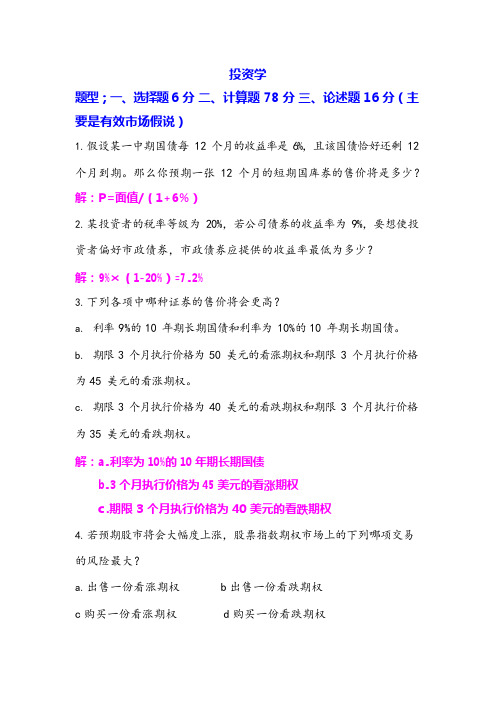
投资学题型;一、选择题 6 分二、计算题 78 分三、论述题 16 分(主要是有效市场假说)1.假设某一中期国债每 12 个月的收益率是 6%,且该国债恰好还剩 12 个月到期。
那么你预期一张 12 个月的短期国库券的售价将是多少?解:P=面值/(1+6%)2.某投资者的税率等级为 20%,若公司债券的收益率为 9%,要想使投资者偏好市政债券,市政债券应提供的收益率最低为多少?解:9%×(1-20%)=7.2%3.下列各项中哪种证券的售价将会更高?a.利率 9%的10 年期长期国债和利率为 10%的10 年期长期国债。
b.期限 3 个月执行价格为 50 美元的看涨期权和期限 3 个月执行价格为45 美元的看涨期权。
c.期限 3 个月执行价格为 40 美元的看跌期权和期限 3 个月执行价格为35 美元的看跌期权。
解:a.利率为10%的10年期长期国债b.3个月执行价格为45美元的看涨期权c.期限 3 个月执行价格为 40 美元的看跌期权4.若预期股市将会大幅度上涨,股票指数期权市场上的下列哪项交易的风险最大?a.出售一份看涨期权 b 出售一份看跌期权c 购买一份看涨期权d 购买一份看跌期权解:a.出售一份看涨期权5.短期市政债券的收益率为4%,应税债券的收益率为6%,当你的税率等级分别为下列情况时,哪一种债券可以提供更高的税后收益率?a.0b.10%c.20%d.30%解:当短期市政债券收益率与应税债券收益率税后收益率相等时,设税率为 X,则:6%(1-X)=4%,解得:X=33.3%由于0、10%、20%、30%都小于33.3%所以在 0、10%、20%、30%的税率时,应税债券可以提供更高的税后收益率。
6.免税债券的利率为 6.4%,应税债券的利率为 8%,两种债券均按面值出售,当投资者的税率等级为多少时投资两种债券是无差别的?解:设税率等级为 X,则:8%(1-X)=6.4%,解得X=20%7.假设你卖空 100 股IBM 的股票,其当前价格为每股 110 美元。
《投资学》练习题及答案

《投资学》计算练习题一、证券估价计算1.A公司即将发行面值为1000元,票面利率为8%,每年付息、到期一次还本的5年期债券。
现有三位投资者拟购买A公司债券并持有到期,他们要求的最低收益率分别为6%、8%和10%。
要求:根据上述资料分别为三个投资者对A公司债券进行估价,并提出投资建议。
解答: 投资者1:PV=1000×8%×(P/A,6%,5)+1000×(P/F,6%,5)≈1083。
96元当A公司债券发行价≤1083。
96元时,可以投资.投资者2:PV=1000×8%×(P/A,8%,5)+1000×(P/F,8%,5)≈1000元当A公司债券发行价≤1000元时,可以投资。
投资者3:PV=1000×8%×(P/A,10%,5)+1000×(P/F,10%,5)≈924。
28元当A公司债券发行价≤924。
28元时,可以投资。
2.某投资者拟在2011年投资A上市公司股票并准备长期持有。
2010年A公司股票每股股息为1元,该投资者要求的最低收益率为10%。
要求:分别就以下两种情况为该投资者对A公司股票进行估价,并提出投资建议。
(1)预计未来A公司股票每股股息将维持2010年水平不变;(2)预计未来A公司股票每股股息将每年递增5% 。
解答(1)PV=1/10%=10元当A公司股票每股市价≤10元时,可以投资。
(2)PV=[1×(1+5%)]/(10%-5%)=21元当A公司股票每股市价≤21元时,可以投资。
二、证券投资(静态)收益率计算1.某投资者投资B公司发行的面值为1000元,票面利率为10%,每年付息、到期一次还本的5年期债券。
要求:分别就以下不相关情况为该投资者计算其投资B公司债券投资收益率.(1)该投资者于债券发行时以面值购入并持有到期;(2)该投资者于债券发行1.5年后以1045元的价格购买并持有到期;(3)该投资者于债券发行时以面值购入并持有4。
投资管理练习试卷5(题后含答案及解析)

投资管理练习试卷5(题后含答案及解析)题型有:1. 单项选择题单项选择题每题只有一个正确答案,请从每题的备选答案中选出一个你认为最正确的答案,在答题卡相应位置上用2B铅笔填涂相应的答案代码。
答案写在试题卷上无效。
1.如果投资项目的预期现金流入量概率分布相同,则( )。
A.现金流量金额越小,其标准差越大B.现金流量金额越大,其期望值越小C.现金流量金额越小,其变化系数越小D.现金流量金额越大,其标准差越大正确答案:D 涉及知识点:投资管理2.在财务管理中,那些由影响所有公司的因素而引起的,不能通过多角化投资分散的风险被称为( )。
A.市场风险B.公司特有风险C.经营风险D.财务风险正确答案:A 涉及知识点:投资管理3.在年限一定的条件下,如果提高利率,则会使得( )。
A.复利现值系数变大B.复利终值系数变小C.普通年金现值系数变小D.普通年金终值系数变小正确答案:C 涉及知识点:投资管理4.现有两个投资项目甲和乙,已知K甲=10%,K乙=15%,δ甲=20%,δ乙=25%,那么( )。
A.甲项目的风险程度大于乙项目的风险程度B.甲项目的风险程度小于乙项目的风险程度C.甲项目的风险程度等于乙项目的风险程度D.不能确定正确答案:A 涉及知识点:投资管理5.当i=10%,N=6时,已知(P/S,10%,6)=0.5645;(S/P,10%,6)=1.7716;(P/A,10%,6)=4.4859;(S/A,10%,6)=7.7156,那么,预付年金现值系数为( )。
A.0.621B.1.9488C.4.9345D.8.4872正确答案:C 涉及知识点:投资管理6.某企业拟建立一项基金,每年年初投入100000元,若利率为10%,五年后该项基金本利和将为( )。
A.671600元B.564100元C.871600元D.610500元正确答案:A 涉及知识点:投资管理7.A方案在三年中每年年初付款500元,B方案在三年中每年年末付款500元,若利率为10%,则两个方案第三年年末时的终值相差( )元。
- 1、下载文档前请自行甄别文档内容的完整性,平台不提供额外的编辑、内容补充、找答案等附加服务。
- 2、"仅部分预览"的文档,不可在线预览部分如存在完整性等问题,可反馈申请退款(可完整预览的文档不适用该条件!)。
- 3、如文档侵犯您的权益,请联系客服反馈,我们会尽快为您处理(人工客服工作时间:9:00-18:30)。
1、The efficient frontier of risky assets isA)the portion of the investment opportunity set that lies above the global minimum variance portfolio.B)the portion of the investment opportunity set that represents the highest standard deviations.C)the portion of the investment opportunity set which includes the portfolios with the lowest standard deviation.D)the set of portfolios that have zero standard deviation.E)both A and B are true.2、 The Capital Allocation Line provided by a risk-free security and N risky securities is ______A) the line that connects the risk-free rate and the global minimum-variance portfolio of the risky securities.B) the line that connects the risk-free rate and the portfolio of the risky securities that has the highest expected return on the efficient frontier.C) the line tangent to the efficient frontier of risky securities drawn from the risk-free rate.D) the horizontal line drawn from the risk-free rate.E) none of the above.3、Consider an investment opportunity set formed with two securities that are perfectly negatively correlated. The global minimum variance portfolio has a standard deviation that is always_____A) greater than zero.B) equal to zero.C) equal to the sum of the securities' standard deviations.D) equal to -1.E) none of the above.4、Which of the following statements is (are) true regarding the variance ofa portfolio of two risky securitiesA) The higher the coefficient of correlation between securities, the greater the reduction in the portfolio variance.B) There is a linear relationship between the securities' coefficient of correlation and the portfolio variance.C) The degree to which the portfolio variance is reduced depends on the degree of correlation between securities.D) A and B.E) A and C.5、Efficient portfolios of N risky securities are portfolios thatA) are formed with the securities that have the highest rates of return regardless of their standard deviations.B) have the highest rates of return for a given level of risk.C) are selected from those securities with the lowest standard deviations regardless of their returns.D) have the highest risk and rates of return and the highest standard deviations.E) have the lowest standard deviations and the lowest rates of return.6、As diversification increases, the total variance of a portfolio approaches ____________.A) 0 B) 1 C) the variance of the market portfolioD) infinity E) none of the above7、The index model was first suggested by ____________.A) Graham B) Markowitz C) Miller D) SharpeE) none of the above8、.A single-index model uses __________ as a proxy for the systematic risk factor.A) a market index, such as the S&P 500B) the current account deficitC) the growth rate in GNPD) the unemployment rateE) none of the above9、According to the index model, covariances among security pairs areA) due to the influence of a single common factor represented by the market index returnB) extremely difficult to calculateC) related to industry-specific eventsD) usually positiveE) A and D10、In a factor model, the return on a stock in a particular period will be related to _________.A) firm-specific events B) macroeconomic events C) the error termD) both A and B E) neither A nor B11、Which of the following statement(s) is (are) true regarding the selection of a portfolio from those that lie on the Capital Allocation LineA) Less risk-averse investors will invest more in the risk-free security and less in the optimal risky portfolio than more risk-averse investors.B) More risk-averse investors will invest less in the optimal risky portfolio and more in the risk-free security than less risk-averse investors.C) Investors choose the portfolio that maximizes their expected utility.D) A and C.E) B and C.12、An investor who wishes to form a portfolio that lies to the right of the optimal risky portfolio on the Capital Allocation Line must:A) lend some of her money at the risk-free rate and invest the remainder in the optimal risky portfolio.B) borrow some money at the risk-free rate and invest in the optimal risky portfolio.C) invest only in risky securities.D) such a portfolio cannot be formed.E) B and C13、Portfolio theory as described by Markowitz is most concerned with:A) the elimination of systematic risk.B) the effect of diversification on portfolio risk.C) the identification of unsystematic risk.D) active portfolio management to enhance returns.E) none of the above.14、The measure of risk in a Markowitz efficient frontier is:A) specific risk.B) standard deviation of returns.C) reinvestment risk.D) beta.E) none of the above.15、A statistic that measures how the returns of two risky assets move together is:A) variance. B) standard deviation. C) covariance. D)correlation.E) C and D.16、Rosenberg and Guy found that __________ helped to predict a firm's beta.A) the firm's financial characteristicsB) the firm's industry groupC) firm sizeD) both A and BE) A, B and C all helped to predict betas.17、If a firm's beta was calculated as 0.6 in a regression equation, Merrill Lynch would state the adjusted beta at a numberA) less than but greater than zero.B) between and .C) between and .D) greater than .E) zero or less.18、The beta of Exxon stock has been estimated as by Merrill Lynch using regression analysis on a sample of historical returns. The Merrill Lynch adjusted beta of Exxon stock would be ___________.A) B) 1.32 C) D) E) none of the above19、Consider the single-index model. The alpha of a stock is 0%. The return on the market index is 16%. The risk-free rate of return is 5%. The stock earns a return that exceeds the risk-free rate by 11% and there are no firm-specific events affecting the stock performance. The β of the stock is _______.A) B) 0.75 C) D) E)20、Suppose you forecast that the market index will earn a return of 15% in the coming year. Treasury bills are yielding 6%. The unadjusted β of Mobil stock is .A reasonable forecast of the return on Mobil stock for the coming year is _________ if you use Merrill Lynch adjusted betas.A) % B) % C) % D) % E) none of the above21、The unsystematic risk of a specific securityA) is likely to be higher in an increasing market.B) results from factors unique to the firm.C) depends on market volatility.D) cannot be diversified away.E) none of the above.22、Which statement about portfolio diversification is correctA) Proper diversification can reduce or eliminate systematic risk.B) The risk-reducing benefits of diversification do not occur meaningfully until at least 50-60 individual securities have been purchased.C) Because diversification reduces a portfolio's total risk, it necessarily reduces the portfolio's expected return.D) Typically, as more securities are added to a portfolio, total risk would be expected to decrease at a decreasing rate.E) None of the above statements is correct.23、Given an optimal risky portfolio with expected return of 12% and standard deviation of 23% and a risk free rate of 3%, what is the slope of the best feasible CALA) B) 0.39 C) D) E)24、Given an optimal risky portfolio with expected return of 13% and standard deviation of 26% and a risk free rate of 5%, what is the slope of the best feasibleCALA) B) 0.14 C) D) E)25、The individual investor's optimal portfolio is designated by:A) The point of tangency with the indifference curve and the capital allocation line.B) The point of highest reward to variability ratio in the opportunity set.C) The point of tangency with the opportunity set and the capital allocation line.D) The point of the highest reward to variability ratio in the indifference curve.E) None of the above.26、The single-index modelA) greatly reduces the number of required calculations, relative to those required by the Markowitz model.B) enhances the understanding of systematic versus nonsystematic risk.C) greatly increases the number of required calculations, relative to those required by the Markowitz model.D) A and B. E) B and C.27、The Security Characteristic Line (SCL)A) plots the excess return on a security as a function of the excess return on the market.B) allows one to estimate the beta of the security.C) allows one to estimate the alpha of the security.D) all of the above. E) none of the above.28、The expected impact of unanticipated macroeconomic events on a security's return during the period isA) included in the security's expected return. B) zero.C) equal to the risk free rate. D) proportional to the firm's beta.E) infinite.29、Covariances between security returns tend to beA) positive because of SEC regulations.B) positive because of Exchange regulations.C) positive because of economic forces that affect many firms.D) negative because of SEC regulationsE) negative because of economic forces that affect many firms.30、One “cost” of the single-index model is that itA) is virtually impossible to apply.B) prohibits specialization of efforts within the security analysis industry.C) requires forecasts of the money supply.D) is legally prohibited by the SEC.E) allows for only two kinds of risk -- macro risk and micro risk.。
